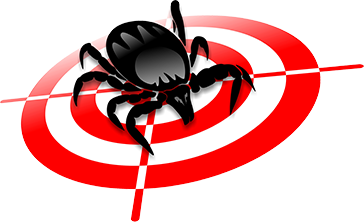
Tick Attack IPM uses a passive approach while yielding effective results by using one of two similar products.
The first is called Tick Box Tick Control System (TCS). If you have concerns about using pesticide
sprays on your property, this may be a good option. Although a very small amount of pesticide is still used,
it is confined to the inside of each Tick Box.
Tick Box TCS constists of nontoxic baiting boxes that attract mice and chipmunks into them, where
they brush against the applicator coated with fipronil. As the rodent’s fur touches the applicator, the ticks get
a fatal dose. The mice and chipmunks are unharmed by the fipronil. These small animals are territorial by nature.
We use this to our advantage, by not killing these rodents, but only killing the ticks on them. This enables
them to hold their territory tick free, and does not allow more tick infested rodents to enter the area.

The second option is Tick Tubes.
Tick Tubes do not rely on bait to attract mice. They use pyrethrin treated cottonballs to assist
them with their nest building. When the mice take these treated cottonballs out of the tube and use them in
building their nest, the ticks are killed, and the mice remain unharmed. Although this process is less costly,
studies have shown the tick box technology is more effective because of the regular feeding habits of both mice
and chipmunks. We do not sell this service, but tick tubes can be a good DIY supplemental plan.
Estimating for Tick Boxes: What is the Process? What to expect.
We will conduct a site visit with you to discuss and determine the best areas to place your perimeter
bait boxes while also establishing your property boundaries. We will identify tick conducive habitats
where mice may need to be managed, and ticks need to be killed, so you and your family, as well as
your pets can safely enjoy your outdoor areas again.
Based on your concerns and needs, our site evaluation will provide you with a detailed written proposal
including a sketch of total linear feet of your perimeter. The sketch will show the proposed placement
of the tick boxes along this perimeter area. Our recommendations will include a plan of action and
suggestions on how to reduce tick habitats. For more detailed information on pricing, please refer
to our FAQs page.
With your acceptance of our proposal determining the size and number of bait boxes around your perimeter
grounds, we will set up your first placement of the tick boxes. From there on, we will provide return
visits per contract. To set up your appointment and estimate go to our
Contact Us page.
Periodically we will contact you to review the effectiveness of the Tick Box Tick Control System. You
may choose to ramp up your offensive measures by increasing the total number of tick boxes, if you
find ticks are returning to your property sooner because of weather conditions or animal traffic dropping
them off.
Good Things to Know
Tick Box TCS Brochure
Click here to download a copy of the Tick Box TCS
brochure. This brochure contains useful information on ticks and how Tick Box TCS can protect you and your
home.
Tick Box TCS Product Label
Click here to download a copy of the Tick Box
TCS product label. This document contains important information on the ingredients used in the product, as well
as usage, safetly and handling information.